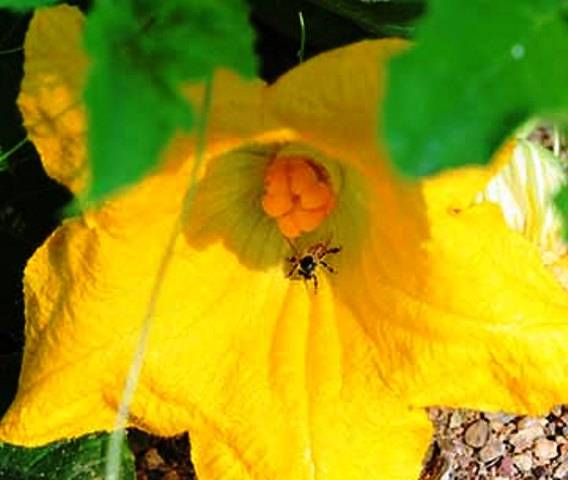
Honey bees while collecting their bee pasturage from flowers of various crops do an important work of pollination for plants. In some crop species, it is so important that bees visit the flower for pollinating and setting any fruit or seed.
Pollination is the transfer of pollen from tile male flower to the female flower of the same or another flower of the same species. Pollination can be carried out by insects, wind, water and in rare instances by animals, other titan insects, including birds and bats.
The most common pollinating agents are wind and insects. Among insects, honey bees are tile most important one since they have a large population living in a colony and collecting pollen and nectar from the flowers. Honey bees have got gregarious behaviour which make possible to keep them in hives and places where pollinations are required. The special contribution of honey bees in the pollination of various crops like fruit trees, bushes, vegetable crops and legume crops are described here.

A. Pollination of fruit trees
Many kinds of insects visits the flowers of fruit trees for their food. The special ability of honey bees to pollinate fruit trees or bushes can be established by an experiment, in which some fruit trees are caged during flowering period along with a bee colony, and some other fruit trees are kept open for other insects to visit in a natural way. The results on plants of strawberries, kept in green house with bees showed that flowers were fully pollinated and produced healthy fruits. Whereas the fruits from uncaged trees were malformed and yield obtained was very poor. Thus, experiment confirmed the role of honey bees in pollination for the fruit trees. Some more advantages of honey bee pollination in fruit trees are given here.

Self pollination
Fruit tree may naturally be a predominantly self-pollinated, but some varieties are definitely benefited in their natural mode of pollination through honey bees. This occurs in such a way that the fruit flowers, which have mature pollen and receptive stigma and waiting for their natural mode of pollination complete their job when visited by bees. The pollen from the anther to the stigma is transferred through the body of the honey bee.
Adequate pollination
The population of the insects other than bees, in many areas have diminished by use of insecticides or fluctuation of climate from year to year. Attempts to increase their population have not been so far proved successful. Therefore, the honey bees are the only insect under human management as pollinating agent. The bees does tile act of pollination adequately and uniformly, as it scrabbles over the anther pulling at them with its legs and biting them. Their body becomes covered with pollen. This helps in uniform and adequate pollination as bees visit flower to flower.
Spread of compatible pollen
Some orchards are inadequately equipped with pollinator varieties. This requires' some artificial means for collecting compatible pollen and also a system to spread the pollen uniformly among compatible varieties. This is done by construction of a bee hive in such a way that each bee going into the hive, has to pass through a 'pollen trap' and empty its pollen pellet. Similarly each outgoing bee, has to walk through a 'pollen dispenser' containing pollen of compatible variety. This system thus helps to collect and spread compatible pollen in the orchards.
B. Pollination of vegetable crops

Among the more important vegetables requiring or benefiting from insect pollination are snap and lima beans, beets, carrots, celery, cole crops, crucifers, cucurbits, egg plant, lettuce, onion, pepper and tomato. Cucurbits i.e. cucumber, pumpkin, squash and melons are especially dependent on the insects for pollination. Therefore, the honey bees can also do the following role in the pollination of vegetable crops.
Uniform pollination
Installing one or more colonies of honey bees per acre increases the total yield and improves fruit size, shape and uniformity of development time. The factors especially important in case of cucumber are result of uniform pollination by bees.
Cross pollination
Successful plant breeding programmes are currently producing vigorous hybrid strains of onion and carrots. Crosses are made using male sterile lines and honey bees to transfer the pollen. The similar breeding technique is now used for recently discovered male sterile lines in vegetables such as soyabeans, tomato and cole crops.
C. Pollination of legumes

Among the most important legumes that are benefited insect pollination are alfalfa (Medicago sativa), clovers (Trifolium), sweet clover (Melilotus), hairy vetch (Vicia villosa), birds foot (Lotus cornicuatus), beans (Vicia faloa). Pollination in legumes are done by a 'tripping mechanism', i.e. as the insect visit the flower, the reproductive parts, anther lobes and stigma enclosed in the keel are forced to come out and touch the body of the insect, by the weight of the insect of its probing activity. Honey bees do not successfully pollinate commercial legume crops like alfalfa grown for seed production. Another type known as alfalfa leaf cutting be Megachile pacifica is found to be completing 70% of the polination activities on seed alfalfa. The alfalfa leaf cutting bee is a favoured pollinator of seed alfalfa in the North latitudes of America. It has a high fidelity to alfalfa bloom and its foraging period is naturally synchronised with alfalfa blooming period. Its gregarious behaviour make it readily manageable for nesting in man made nesting places.
Still another bee known as alkali bee (Nomia melanderi) is an important insect in alfalfa seed production of the Pacific north west. It is a major pollinator up to 30 per cent of the acreage.















